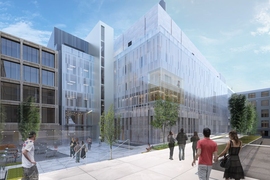“I’ve never experienced this!” The researcher from Mexico was referring to the 7 degrees Fahrenheit weather outside Building 39 at MIT last month, but his comment might also apply to the outright excitement he and seven colleagues conveyed in recent interviews about their stay at the Institute. The eight faculty and postdocs are here as part of the Tec de Monterrey and MIT Program, a formal relationship established between MIT and the Tecnológico de Monterrey in 2014 and launched in early 2015. The program aims to foster exchanges and collaborations among researchers at both institutions focused on the general area of nanotechnology and nanoscience with the ultimate goal of supporting the Tec in its quest to become a research university.
Tecnológico de Monterrey, founded by MIT Class of 1914 graduate Eugenio Garza Sada in 1943 and initially directed by León Álvalos y Vez '29, is one of the largest universities in Latin America with more than 90,000 students. The Tec de Monterrey and MIT Program was established by a gift from the Garza family to honor the 100th anniversary of Eugenio Garza Sada’s graduation from MIT’s Department of Civil and Sanitary Engineering.
The exchange program is housed at MIT’s Microsystems Technology Laboratories (MTL), under the leadership of Professor Jesús del Alamo of the Department of Electrical Engineering and Computer Science. A primary goal of the program is to pair professors and postdocs from Monterrey Tec with host faculty at MIT, creating opportunities for them to collaborate on world class-research at the leading edge of their fields. “We are hoping to get really smart, driven and enthusiastic young people,” said del Alamo, with “fruitful collaboration” as the benefit for both schools.
As del Alamo described it, the program covers engineering of systems and structures at any scale, with initial emphasis on nanoscience and nanotechnology, “broadly construed.” The inaugural cohort of participants in the Monterrey Tec program includes three faculty and five postdocs who have come to MIT for visits ranging from a semester to the full academic year. In 2016, the program will expand to include graduate students. At the end of five years the program’s focus on nanotechnology will be reviewed, with modifications made as needed, del Alamo said.
The visiting Monterrey Tec faculty and postdocs bring expertise in diverse fields, including telecommunications, biotechnology, chemical engineering, mechatronics, molecular biology, microfluidics, acoustics engineering, and more, but in separate interviews they described having similar goals. Many came with a desire to learn more about how their MIT peers think, how they use tools and logic, while others wanted to expand the reach of their own research and that of their home university; in a word, to “grow.” Most emphatically, the visitors expressed a strong desire to forge permanent connections between people at both institutions and to demonstrate the mutual value of these research collaborations.
The researchers are working on a range of projects at MTL and MTL-affiliated labs and centers, and talked about their work with unqualified excitement. For example, acoustics engineer David Isaac Ibarra-Zarate described his experience working with Brian Anthony and others in the Medical Electronic Device Realization Center as “since the beginning wonderful.” The researcher’s main goal is to develop a micro-electric system that can deliver acoustic therapies to the ear, and he has been working with a Mexico City hospital to develop protocols for this therapy. Drawn to the project in part for personal reasons (his father has tinnitus), Ibarra-Zarate intends to develop a device, standards, and protocol, and perhaps bring it to market. While at MIT he hopes to complete the first step, which is constructing a prototype. With his signal processing experience, the researcher was also invited to join a project to devise an ultrasound pill that can be swallowed to yield an image of the intestines, and he is hopeful of reaching the prototype stage with this pill as well. Beyond these efforts, he is interested in exploring the brain-computer interface, he said, and in correlating encephalography signals with acoustic sensation and binaural sounds.
José González-Valdez vividly described his work in Professor Scott Manalis’s lab at the Koch Institute in a similarly enthusiastic vein. The group is “measuring the weights of exosomes “at a very precise, attogram, scale,” in order to characterize different exosome populations, he said. Exosomes are extracellular vesicles or tiny sacs filled with liquid. The intent is to link one of the exosome populations with the symptoms of patients who have what's known as vestibular schwannoma, a cancer of the cerebellum that can leave people blind or deaf. González-Valdez explained that a group he works with in Mexico has been using chromatography to separate molecules. “There’s a protocol,” he said, “but it’s not that efficient — it’s quite tough to do.” His hope, he continued, is to connect the “exosome people” (in Cambridge) and the “bio-separation people” in Mexico, to continue and broaden this critical effort.
Biotechnologist Grissel Trujillo-de Santiago, whose PhD focused on biomaterials, described her work on tissue engineering in Professor Ali Khademhosseini’s lab at the Brigham and Women’s Hospital as “a very powerful experience.” The researcher used the analogy of homespun ingredients — milk and coffee — to explain how she is making use of chaotic flows to develop microstructures that become small pieces of tissue. Trujillo-de Santiago hopes to set up her own group for biomaterials and tissue engineering when she returns to Mexico. “The applications would be infinite — it’s a matter of imagination,” she exclaimed, opening a tablet computer and displaying slides of pink and green fluorescent particles in a polymer solution to illustrate these microstructure platforms.
Professor Mario Moisés Alvarez, trained in chemical and biological engineering, is also working in the Khademhosseini Lab, focusing on biotechnology and on biomedical technology projects. His research group at Tecnológico de Monterrey had developed proteins that can be used to detect the Ebola virus, and he spoke of how elated he is to be part of a team here leveraging the use of those protein molecules, in combination with nanoparticles and a microfluidic chamber, to detect and capture Ebola viral particles from a patient’s circulating blood — “at the point at which you can still save a life!”
A “microfluidics device designer” is how José Israel Martinez-López describes himself. Trained in electrical engineering and biotechnology and with a PhD in mechatronics and advanced materials, he is working with Professor Jongyoon Han’s group in the Research Laboratory of Electronics (RLE). The large-group environment allows him to “get a glimpse” of topics in related fields, and is proving “very helpful for professional growth,” he said. Martinez-López is helping to devise rapid microfabrication methodologies that will enable developing countries to manufacture devices for disease detection close to the site where the devices are needed, using off-the-shelf materials. The goal is “functionality at low cost,” he stated, stressing the enormous need for these tools.
All program participants used high praise to describe their experience working with MIT mentors and lab mates. Daniel Olvera Trejo, a mechatronics engineer specializing in machine processes, vibrations, and tools, is working on projects in the MTL lab of Luis Fernando Velásquez-Garcia. Experienced in conventional microfabrication, the researcher is now exploring even more accurate technologies, such as 3-D printing and stereophotography, to design new devices; for example, tools to control drug release. “People always make time to get you what you need,” he said. One important aspect of his experience in the program has been to see how people at MIT work together across disciplines, said Olvera Trejo. Once home, he hopes to increase collaboration between researchers with expertise in mechanics, chemistry, and manufacturing, and the physicians in Monterrey’s hospital who have applications for new devices.
The researchers will return to Mexico by the end of this semester, and they spoke eagerly of what they expect to bring back. “People here are very committed, they are very connected,” said Monterrey Tec Professor Rodrigo Balam Muñoz Soto of his experience in the RLE lab of Professor Joel Voldman, working with pairing-cell devices. A molecular biologist, Muñoz Soto noted that these devices have many potential diagnostic uses, and said that his microfluidics and microsystems work here will have “immediate application” in the molecular diagnostics and immunology courses he is teaching next semester.
Monterrey Tec Professor Gerardo Antonio Castañón Avila, a telecommunications engineer by training, has been working on silicon photonics in the research laboratory of Professor Rajeev Ram, using concepts of electronics to design wave guides at the nano level. Researchers at MIT “are working with very relevant problems — and that is difficult to find,” he remarked. There are advantages in coupling photonics with electronics such as is being done here, Avila said, and he plans to set up a nanophotonics lab at Monterrey Tec, where fabrication can be done more easily and products can be tested.
Researchers outlined many more goals, such as publishing journal articles on their work here; devising new courses in areas like silicon photonics; increasing the number of point-of-care applications in their work; and translating the experience of MIT’s cross-disciplinary thinking to Monterrey. Several said they plan to invite MIT faculty to Monterrey Tec to lecture on microsystems-related work, and to send ambitious Monterrey graduate students to MIT. Perhaps the most commonly mentioned plan was a human one. As Muñoz Soto emphatically said, “My next goal is to keep the relationship [with MIT] alive!”










